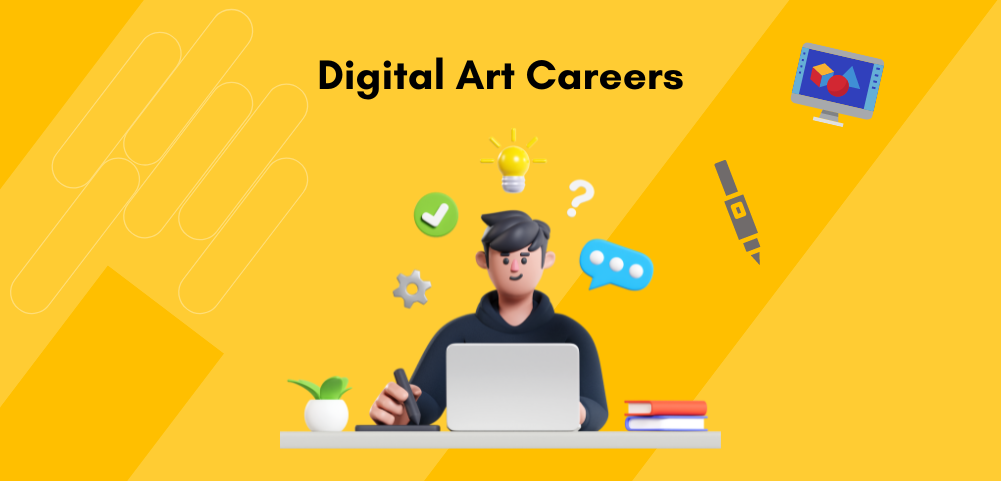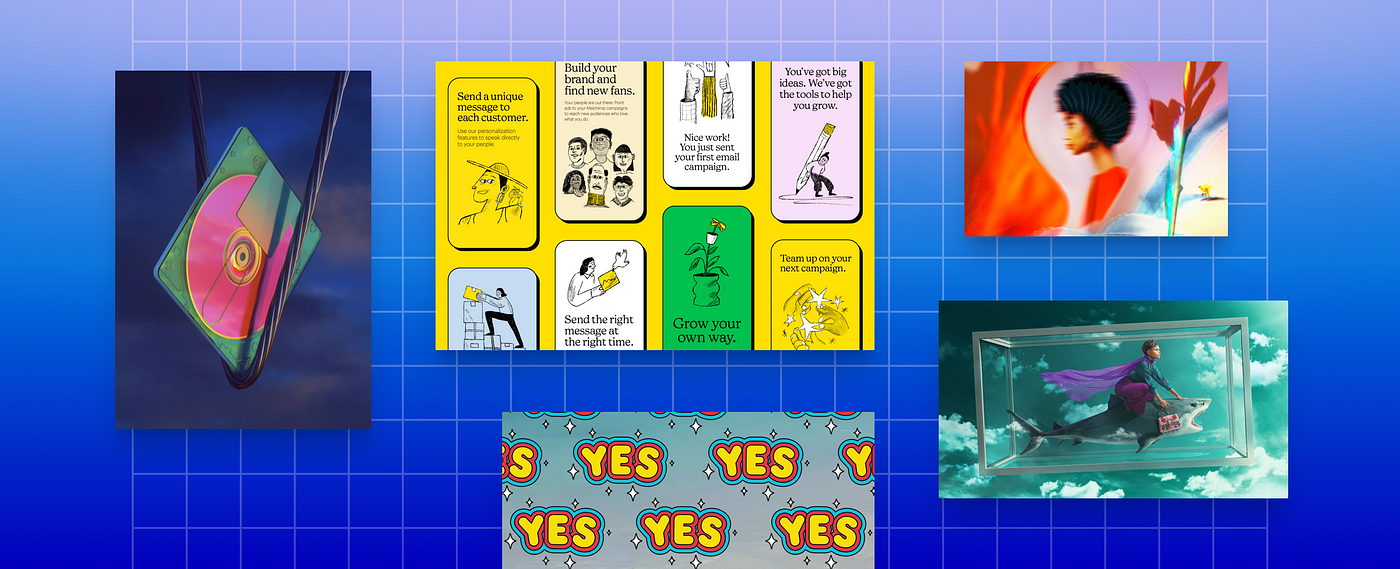How can Digital Art open career doors for hobbyists?
by Arthur Yang December 8, 2023

Digital art evolved from traditional art styles in the physical form.
Traditional art has been seen more of as a hobby and creative pastime.
But with the advent of internet growth and digital media, digital art forms are starting turning into compatible career options for artists.
Check out how you can turn your hobby into a career!
1. Balancing Passion vs Practicality
2. Importance of a Creative Portfolio
4. Three Essential Skills for Digital Artists
3. Career Opportunities
5. Freelancing
6. Conclusion
Let’s start!
Digital Art Career
Digital Art Career
Digital Art Career
Balancing Passion vs Practicality

In the pursuit of turning a passion for art-making into a viable career, finding the delicate equilibrium between passion and practicality becomes paramount.
While the love for creating art is the driving force behind an artist’s journey, practical considerations are essential for ensuring sustainability and success in the long run.
Passion fuels creativity and motivates artists to push their boundaries, experiment with new styles, and invest countless hours perfecting their craft.
It’s the emotional connection to the art that gives it authenticity and resonance.
However, passion alone may not always translate into financial stability or widespread recognition.
Practicality, on the other hand, involves strategic decision-making.
This includes understanding market trends, identifying potential income streams, and developing a professional approach to one’s art.
Embracing practical aspects does not diminish the passion; rather, it enhances the likelihood of transforming artistic endeavours into a sustainable career.
In essence, the pursuit of a fulfilling career in art requires a delicate dance between passion and practicality.
In line with the Japanese Ikigai framework, there needs to be a balance between what you love and what you can be paid for.
This would naturally lead to a career that is fulfilling to the individual.
Embrace passion as the driving force behind your creativity, but also supplement it with practical considerations that ensure the longevity and success of an artistic career.
By finding this equilibrium, artists can navigate the complex landscape of the art world with confidence and purpose.
Importance of a Creative Portfolio

In the competitive landscape of digital art, a well-curated portfolio is not just a collection of work.
It is a visual resume that speaks volumes about the person’s skills, creativity, and artistic identity.
A portfolio is often the first interaction potential employers or clients have with your work.
A strong first impression through your portfolio can set a positive tone for the entire job application process.
In a portfolio, you should showcase your technical skills and artistic expertise.
It allows employers to gauge your proficiency in various tools, techniques, and styles.
Look to include a diverse range of projects to showcase your adaptability and mastery across different aspects of digital art.
Many artists make a mistake in only including their final works.
As a previous recruiter, I encourage artists to include their process work as well.
This includes sketches, drafts, and progress shots that not only adds depth but also provides insight into your workflow and problem-solving abilities.
This helps shows your soft skills, and thinking process, which is not visible from the final work.
Three Essential Skills for Digital Artists
#1 — Technical Proficiency
Technical proficiency is the mastery of digital art software and tools, and an understanding of the specific techniques within your chosen medium, whether it be digital painting, vector art, or 3D modelling.
This expertise not only allows you to bring your imaginative visions to life but also demonstrates versatility and adaptability across various styles and projects.
Digital artists must wield a deep understanding of digital tools and software, seamlessly navigating the intricate landscape of programs like Adobe Creative Suite, Procreate, or 3D modeling software.
Whether it’s wielding brushes with finesse in digital painting or sculpting intricate 3D models, technical prowess forms the backbone of a digital artist’s craft, ensuring their creative visions materialise seamlessly onto the digital canvas.
#2 — Creativity
At the heart of digital art lies the indispensable skill of creativity and artistic expression.
The ability to think creatively, conceptualise original ideas, and visually articulate them distinguishes a remarkable digital artist.
This skill encompasses cultivating a unique artistic voice, possessing a keen sense of composition, and an understanding of colour theory.
It involves the ability to conceptualise, ideate, and bring forth a visual narrative that captivates audiences, setting the artist’s work apart in a sea of digital creations.
Creativity serves as the driving force, breathing life and individuality into the artist’s work, capturing the attention and emotions of viewers.
#3 — Attention to detail
In the intricate world of digital art, meticulous care in refining each element, whether it be brush strokes, textures, or overall composition, ensures a polished and refined final product.
This attention to detail elevates the professionalism of your work, showcasing a dedication to craftsmanship.
As foundational skills, technical proficiency, creativity, and attention to detail collectively contribute to the arsenal of a digital artist, forming the basis for a successful and fulfilling career in the ever-evolving landscape of digital art.
Career Opportunities

#1 — Graphic Designer
Graphic designers are visual communicators who create captivating and impactful designs for a variety of mediums.
They work with clients to understand their branding needs, develop visual concepts, and produce designs for print and digital platforms.
Graphic designers can be found in marketing agencies, in-house design teams, or as freelancers.
Graphic designers can advance their careers by specialising in areas like web design, branding, or user interface design.
They may also move into art direction roles, where they oversee the visual aspects of projects and guide junior designers.
#2 — Animator
Animators breathe life into static images, creating movement and storytelling through visual sequences.
They can work in various industries, including film, television, video games, and advertising.
Animators use digital tools to produce 2D or 3D animations, bringing characters and scenes to life.
Animators can advance their careers by specialising in specific animation techniques (e.g. character animation, motion graphics) or by taking on leadership roles such as animation director or supervisor.
They may also explore opportunities in emerging fields like virtual reality (VR) or augmented reality (AR) animation.
#3 — 3D Modeller
3D modellers create three-dimensional objects and characters using digital tools.
They play a crucial role in industries such as gaming, film, architecture, and virtual reality.
3D modellers bring concepts to life by designing and sculpting detailed models that can be animated or used in virtual environments.
3D modellers can advance by specialising in areas like character modelling, environment design, or product visualisation.
They may also progress into roles such as lead modeller or art director, overseeing the visual aspects of larger projects.
In all three career paths, continuous learning and staying abreast of industry trends are crucial for professional growth.
Digital artists in these roles often find opportunities to contribute to exciting and innovative projects, making a significant impact in their respective fields.
Freelancing
Freelancing presents a dynamic and appealing alternative to traditional employment, offering distinct advantages that cater to the evolving preferences of many professionals.
The chief strength lies in the freedom and flexibility it affords, allowing freelancers to dictate their schedules, work environments, and project choices.
Autonomy and independence are paramount, empowering freelancers to make decisions aligned with their personal goals and values.
Diverse project opportunities contribute to continuous skill development, fostering adaptability and professional growth.
The potential for higher earnings is a notable draw, with freelancers setting their rates and managing multiple projects simultaneously.
You can also attract a diverse clientele from around the world, offering global opportunities that might not be available in traditional job settings.
Reduced commuting stress, customisable work environments, and entrepreneurial opportunities further solidify freelancing’s appeal.
Despite these strengths, freelancing comes with challenges that require self-discipline and effective management of administrative tasks.
As individuals weigh the pros and cons, the allure of a freelance career lies in its promise of independence, variety, and the potential for substantial financial returns.
Consider using platforms like Fiverr to source for potential clients!
Conclusions
Digital art is becoming more accessible and widespread.
If you are a amateur hobbyist, do consider marketing your skill as a side hustle.
Feel free to check out our course on Digital Art with Procreate here.
You can also contact us via the chatbot or simply drop us a DM on our Instagram page if you’d like.
. . . . .
